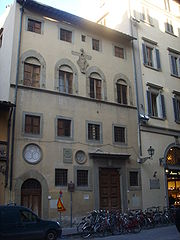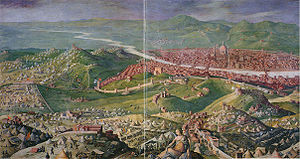
Gonfaloniere of Justice
Encyclopedia
- For similar offices in other Italian city states, see GonfaloniereGonfaloniereThe Gonfaloniere was a highly prestigious communal post in medieval and Renaissance Italy, notably in Florence and the Papal States. The name derives from gonfalone, the term used for the banners of such communes....
.
Gonfaloniere of Justice (Gonfaloniere di Giustizia) was a post in the government of medieval and early Renaissance Florence
History of Florence
Florence is a major historical city in Italy, distinguished as one of the most outstanding economical, cultural, political and artistic centres in the peninsula from the late Middle Ages to the Renaissance.-Prehistoric evidence:...
. Like Florence's Podestà
Podestà
Podestà is the name given to certain high officials in many Italian cities, since the later Middle Ages, mainly as Chief magistrate of a city state , but also as a local administrator, the representative of the Emperor.The term derives from the Latin word potestas, meaning power...
and Priori, it was introduced in 1293 when Giano Della Bella's Ordinamenti di Giustizia came into force.
He was one of the nine citizens selected by drawing lots every two months, who formed the government, or Signoria
Signoria of Florence
The Signoria was the government of medieval and renaissance Florence. Its nine members, the Priori, were chosen from the ranks of the guilds of the city: six of them from the major guilds, and two from the minor guilds...
. As Gonfaloniere di Giustizia he was the temporary standard-bearer of the Republic of Florence
Republic of Florence
The Republic of Florence , or the Florentine Republic, was a city-state that was centered on the city of Florence, located in modern Tuscany, Italy. The republic was founded in 1115, when the Florentine people rebelled against the Margraviate of Tuscany upon Margravine Matilda's death. The...
and custodian of the city's banner, which was displayed from the yardarm of a portable cross. Along with the voting rights of the other Priori, he was also in charge of the internal security forces and the maintenance of public order. To distinguish him from his other eight colleagues, his crimson coat, lined with ermine, was further embroidered with golden stars. Each of Florence's neighborhoods, or rioni, had its own priore who might be selected to serve on the council, and its own gonfaloniere di compagnia selected from the first families of each quarter.
Prelude

Hundred Years' War
The Hundred Years' War was a series of separate wars waged from 1337 to 1453 by the House of Valois and the House of Plantagenet, also known as the House of Anjou, for the French throne, which had become vacant upon the extinction of the senior Capetian line of French kings...
dragged even the Bardi and Peruzzi businesses (with latter alone owed around 600,000 guilders) into ruin.
The Priory of Arts

After the Ordinances

Medici
The House of Medici or Famiglia de' Medici was a political dynasty, banking family and later royal house that first began to gather prominence under Cosimo de' Medici in the Republic of Florence during the late 14th century. The family originated in the Mugello region of the Tuscan countryside,...
on their return to the city in 1530. Indeed, in the 15th century the post was given to many members of the Medici family and their neighbouring and allied families, giving them a kind of recognised power within the republican framework and de facto (though never de iure) allowing them to take over the powers of the other old magistracies.
After the expulsion of Piero the Unfortunate in 1494 and during the brief rule of Girolamo Savonarola
Girolamo Savonarola
Girolamo Savonarola was an Italian Dominican friar, Scholastic, and an influential contributor to the politics of Florence from 1494 until his execution in 1498. He was known for his book burning, destruction of what he considered immoral art, and what he thought the Renaissance—which began in his...
(executed in 1498), the Florentine families tried to reorganise the city government on the model of the old communal magistracies. Pier Soderini was in 1502 appointed gonfaloniere for life, but only held it until the end of 1512, when the Medici returned and Piero decided to abandon the city. During his tenureship, Soderini held more direct political responsibility than either Cosimo de' Medici
Cosimo de' Medici
Còsimo di Giovanni degli Mèdici was the first of the Medici political dynasty, de facto rulers of Florence during much of the Italian Renaissance; also known as "Cosimo 'the Elder'" and "Cosimo Pater Patriae" .-Biography:Born in Florence, Cosimo inherited both his wealth and his expertise in...
or Lorenzo de' Medici
Lorenzo de' Medici
Lorenzo de' Medici was an Italian statesman and de facto ruler of the Florentine Republic during the Italian Renaissance. Known as Lorenzo the Magnificent by contemporary Florentines, he was a diplomat, politician and patron of scholars, artists and poets...
. Machiavelli served as his secretary. Although many of the Ottimati or aristocrats had supported Soderini's candidacy for Gonfaloniere a Vita, believing he would support their interests, they turned against him when his popular leanings became clear. In 1512, after fierce resistance to imperial troops under Charles V
Charles V, Holy Roman Emperor
Charles V was ruler of the Holy Roman Empire from 1519 and, as Charles I, of the Spanish Empire from 1516 until his voluntary retirement and abdication in favor of his younger brother Ferdinand I and his son Philip II in 1556.As...
and pope Julius II
Pope Julius II
Pope Julius II , nicknamed "The Fearsome Pope" and "The Warrior Pope" , born Giuliano della Rovere, was Pope from 1503 to 1513...
, it was finally forced to surrender. This marked the end of the republican dream and its offices, with the start of the ascent of the grand-ducal Medici dynasty.

